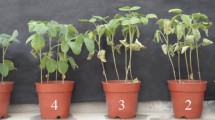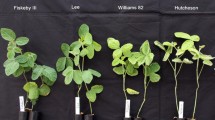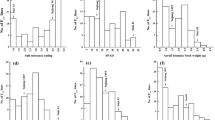Abstract
Salt tolerance in soybean [Glycine max (L.) Merr.] is controlled by major quantitative trait loci (QTL) or single gene(s). Among soybean germplasm, wild soybean plant introduction PI 483463 was reported to have a single dominant gene for salt tolerance. The objective of this study was to genetically map the QTL in a recombinant inbred line (RIL) population derived from a cross between PI 483463 and Hutcheson. Simple sequence repeat (SSR) markers and universal soybean single nucleotide polymorphism (SNP) panel (the USLP 1.0) were utilized for molecular genotyping. The RILs were phenotyped in two independent tests in a greenhouse using a 1–5 scale visual rating method. The results showed that the salt tolerant QTL in PI 483463 was mapped to chromosome 3 in a genomic region between the Satt255 and BARC-038333-10036 markers. The favorable allele inherited from PI 483463 conferred tolerance to salinity and had an additive effect on reducing leaf scorch. A subset of 66 iso-lines was developed from the F3 families of the same cross and was used for genetic confirmation of the QTL. The integration of recombination events and the salt reaction data indicate that the QTL is located in the region of approximately a 658 kb segment between SSR03_1335 at nucleotide 40,505,992 and SSR03_1359 at nucleotide 41,164,735 on chromosome 3. This narrow region can facilitate further genomic research for salt tolerance in soybean including cloning salt tolerance genes.



Similar content being viewed by others
References
Abel GH (1969) Inheritance of the capacity for chloride inclusion and chloride exclusion by soybeans. Crop Sci 9:697–698
Apse MP, Aharon GS, Snedden WA, Blumwald E (1999) Salt tolerance conferred by overexpression of a vacuolar Na+/H+ antiport in Arabidopsis. Science 285:1256–1258
Cazalé A-C, Clément M, Chiarenza S, Roncato M-A, Pochon N, Creff A, Marin E, Leonhardt N, Noël LD (2009) Altered expression of cytosolic/nuclear HSC70-1 molecular chaperone affects development and abiotic stress tolerance in Arabidopsis thaliana. J Exp Bot 60:2653–2664
Chen H, Cui S, Fu S, Gai J, Yu D (2008) Identification of quantitative trait loci associated with salt tolerance during seedling growth in soybean (Glycine max L.). Aust J Agric Res 59:1086–1091
Chinnusamy V, Jagendorf A, Zhu JK (2005) Understanding and improving salt tolerance in plants. Crop Sci 45:437–448
Chung WS, Lee SH, Kim JC, Do Heo W, Kim MC, Park CY, Park HC, Lim CO, Kim WB, Harper JF, Cho MJ (2000) Identification of a calmodulin-regulated soybean Ca2+-ATPase (SCA1) that is located in the plasma membrane. Plant Cell 12:1393–1407
Churchill GA, Doerge RW (1994) Empirical threshold values for quantitative trait mapping. Genetics 138:963–971
Fan JB, Gunderson KL, Bibikova M, Yeakley JM, Chen J, Wickham Garcia E, Lebruska LL, Laurent M, Shen R, Barker D (2006) Illumina universal bead arrays. Methods Enzymol 410:57–73
Fehr WR, Caviness CE, Burmood DT, Pennington JS (1971) Stage of development descriptions for soybeans, Glycine Max (L.) Merrill. Crop Sci 11:929–931
Fukuda A, Nakamura A, Tagiri A, Tanaka H, Miyao A, Hirochika H, Tanaka Y (2004) Function, intracellular localization and the importance in salt tolerance of a vacuolar Na+/H+ antiporter from rice. Plant Cell Physiol 45:146–159
Hamwieh A, Xu D (2008) Conserved salt tolerance quantitative trait locus (QTL) in wild and cultivated soybeans. Breed Sci 58:355–359
Hamwieh A, Tuyen D, Cong H, Benitez E, Takahashi R, Xu D (2011) Identification and validation of a major QTL for salt tolerance in soybean. Euphytica 179:451–459
Hyten D, Song Q, Choi IY, Yoon MS, Specht J, Matukumalli L, Nelson R, Shoemaker R, Young N, Cregan P (2008) High-throughput genotyping with the golden gate assay in the complex genome of soybean. Theor Appl Genet 116:945–952
Hyten DL, Choi IY, Song Q, Specht JE, Carter TE, Shoemaker RC, Hwang EY, Matukumalli LK, Cregan PB (2010) A high density integrated genetic linkage map of soybean and the development of a 1,536 universal soy linkage panel for QTL mapping. Crop Sci 50:960–968
Kao WY, Tsai TT, Tsai HC, Shih CN (2006) Response of three Glycine species to salt stress. Environ Exp Bot 56:120–125
Katerji N, van Hoorn JW, Hamdy A, Mastrorilli M (2003) Salinity effect on crop development and yield, analysis of salt tolerance according to several classification methods. Agric Water Manag 62:37–66
Kim MY, Lee S, Van K, Kim T-H, Jeong SC, Choi IY, Kim DS, Lee Y-S, Park D, Ma J, Kim WY, Kim BC, Park S, Lee KA, Kim DH, Kim KH, Shin JH, Jang YE, Kim KD, Liu WX, Chaisan T, Kang YJ, Lee YH, Kim KH, Moon JK, Schmutz J, Jackson SA, Bhak J, Lee SH (2010) Whole-genome sequencing and intensive analysis of the undomesticated soybean (Glycine soja Sieb. and Zucc.) genome. PNAS 107:22032–22037
Kosambi DD (1944) The estimation of map distances from recombination values. Ann Eugen 12:172–175
Lauchli A (1984) Salt exclusion: an adaptation of legumes for crops and pastures under saline conditions. In: Staples RC, Toeniessen GH (eds) Salinity tolerance in plants: strategies for crop improvement. Wiley, New York, pp 171–187
Lee GJ, Boerma HR, Villagarcia MR, Zhou X, Carter TE, Li Z, Gibbs MO (2004) A major QTL conditioning salt tolerance in S-100 soybean and descendent cultivars. Theor Appl Genet 109:1610–1619
Lee JD, Smothers SL, Dunn D, Villagarcia M, Shumway CR, Carter TE, Shannon JG (2008) Evaluation of a simple method to screen soybean genotypes for salt tolerance. Crop Sci 48:2194–2200
Lee JD, Shannon JG, Vuong TD, Nguyen HT (2009) Inheritance of salt tolerance in wild soybean (Glycine soja Sieb. and Zucc.) accession PI483463. J Hered 100:798–801
Lenis JM, Ellersieck M, Blevins DG, Sleper DA, Nguyen HT, Dunn D, Lee JD, Shannon JG (2011) Differences in ion accumulation and salt tolerance among Glycine accessions. J Agron Crop Sci 197:302–310
Li WYF, Wong FL, Tsai SN, Phang TH, Shao G, Lam HM (2006) Tonoplast-located GmCLC1 and GmNHX1 from soybean enhance NaCl tolerance in transgenic bright yellow (BY)-2 cells. Plant Cell Environ 29:1122–1137
Luo Q, Yu B, Liu Y (2005) Differential sensitivity to chloride and sodium ions in seedlings of Glycine max and G. soja under NaCl stress. J Plant Physiol 162:1003–1012
Pantalone VR, Kenworthy WJ, Slaughter LH, James BR (1997) Chloride tolerance in soybean and perennial Glycine accessions. Euphytica 97:235–239
Park SY, Seo SB, Lee SJ, Na JG, Kim YJ (2001) Mutation in PMR1, a Ca2+-ATPase in golgi, confers salt tolerance in saccharomyces cerevisiae by inducing expression of PMR2, an Na+-ATPase in plasma membrane. J Biol Chem 276:28694–28699
Pathan MS, Lee JD, Shannon JG, Nguyen HT (2007) Recent advances in breeding for drought and salt stress tolerance in soybean. In: Jenks MA, Hasegawa PM, Jain SM (eds) Advances in molecular breeding towards salinity and drought tolerance. Springer, Dordrecht, pp 739–773
Phang TH, Shao G, Lam HM (2008) Salt tolerance in soybean. J Integr Plant Biol 50:1196–1212
Rengasamy P (2006) World salinization with emphasis on Australia. J Exp Bot 57:1017–1023
Schmutz J, Cannon SB, Schlueter J, Ma J, Mitros T, Nelson W, Hyten DL, Song Q, Thelen JJ, Cheng J, Xu D, Hellsten U, May GD, Yu Y, Sakurai T, Umezawa T, Bhattacharyya MK, Sandhu D, Valliyodan B, Lindquist E, Peto M, Grant D, Shu S, Goodstein D, Barry K, Futrell-Griggs M, Abernathy B, Du J, Tian Z, Zhu L, Gill N, Joshi T, Libault M, Sethuraman A, Zhang XC, Shinozaki K, Nguyen HT, Wing RA, Cregan P, Specht J, Grimwood J, Rokhsar D, Stacey G, Shoemaker RC, Jackson SA (2010) Genome sequence of the palaeopolyploid soybean. Nature 463:178–183
Song Q, Jia G, Zhu Y, Grant D, Nelson RT, Hwang EY, Hyten DL, Cregan PB (2010) Abundance of SSR motifs and development of candidate polymorphic SSR Markers (BARCSOYSSR_1.0) in soybean. Crop Sci 50:1950–1960
Soystats (2012) Soystats. A reference guide to important soybean facts and figures. The American Soybean Association. http://www.soystats.com
Sun Y, Wang D, Bai Y, Wang N, Wang Y (2006) Studies on the overexpression of the soybean GmNHX1 in Lotus corniculatus; The reduced Na+ level is the basis of the increased salt tolerance. Chin Sci Bull 51:1306–1315
Van Ooijen JH, Voorrips RE (2001) JoinMap 3.0 software for the calculation of genetic linkage maps. Plant Research International, Wageningen
Voorrips RE (2002) MapChart: software for the graphical presentation of the linkage maps and QTLs. J Hered 93:77–78
Vuong T, Sleper D, Shannon J, Nguyen H (2010) Novel quantitative trait loci for broad-based resistance to soybean cyst nematode (Heterodera glycines Ichinohe) in soybean PI 567516C. Theor Appl Genet 121:1253–1266
Vuong T, Sleper D, Shannon J, Wu X, Nguyen H (2011) Confirmation of quantitative trait loci for resistance to multiple-HG types of soybean cyst nematode (Heterodera glycines Ichinohe). Euphytica 181:101–113
Wu CA, Yang GD, Meng QW, Zheng CC (2004) The cotton GhNHX1 gene encoding a novel putative tonoplast Na+/H+ antiporter plays an important role in salt stress. Plant Cell Physiol 45:600–607
Xue ZY, Zhi DY, Xue GP, Zhang H, Zhao YX, Xia GM (2004) Enhanced salt tolerance of transgenic wheat (Tritivum aestivum L.) expressing a vacuolar Na+/H+ antiporter gene with improved grain yields in saline soils in the field and a reduced level of leaf Na+. Plant Sci 167:849–859
Zhang HX, Blumwald E (2001) Transgenic salt-tolerant tomato plants accumulate salt in foliage but not in fruit. Nat Biotech 19:765–768
Acknowledgments
This research was supported by Kyungpook National University Research Fund, 2012 and a Grant from the Next-Generation BioGreen 21 Program (No. PJ009091), Rural Development Administration, Republic of Korea.
Author information
Authors and Affiliations
Corresponding author
Additional information
Bo-Keun Ha and Tri D. Vuong contributed equally to this work.
Electronic supplementary material
Below is the link to the electronic supplementary material.
10681_2013_944_MOESM1_ESM.docx
Fig. S1 Salt reaction of three different soybean genotypes. A. The effect of 18 days of salt treatments. B. the effect of 30 days of salt treatments. Soybean lines were planted in seedling trays (27 W x 53L x 13H cm) with 50 holes. Each hole with approximately 345 ml volume was filled with a sandy soil. At the V2-V3 growth stage (Fehr et al. 1971) seedlings of parents and S-100 were placed in 39 L Sterilite containers (Sterilite, Towsend, MA, USA) with 100 mM NaCl solution to determine salt reaction (DOCX 1021 kb)
Rights and permissions
About this article
Cite this article
Ha, BK., Vuong, T.D., Velusamy, V. et al. Genetic mapping of quantitative trait loci conditioning salt tolerance in wild soybean (Glycine soja) PI 483463. Euphytica 193, 79–88 (2013). https://doi.org/10.1007/s10681-013-0944-9
Received:
Accepted:
Published:
Issue Date:
DOI: https://doi.org/10.1007/s10681-013-0944-9




